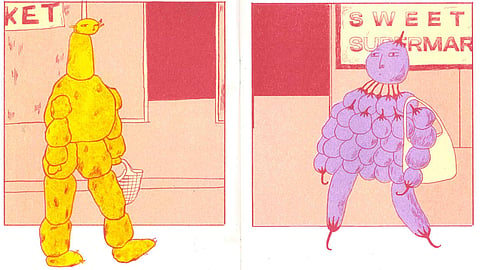
- HOMEGROWN WORLD
- #HGCREATORS
- #HGEXPLORE
- #HGVOICES
- #HGSHOP
- CAREERS
- ABOUT US
- CONTACT US

Nursery rhymes are often our first brush with language. We retain them long before we can actually read and carry them in our mouths like song. They’re playful, yes, but also foundational. Coded with social cues and linguistic patterns, they shape early speech, introducing rhythm and narrative, and offering children a way to make sense of the world around them. In India, they also carry a deep cultural charge — each region boasting its own lyrical inventory, rich with references to food, folklore, seasons, and idioms unique to its soil.
It’s from this exact place of cultural imprint that artist and illustrator Sana Bansal creates Aloo Kachaloo, a self-published mini-comic, that reinterprets the beloved Hindi rhyme through an artist's lens. In her telling, Aloo Kachaloo becomes a metaphorical reunion between estranged friends who collide awkwardly in the mundane setting of a supermarket.
The illustrations in the comic are vibrant, expressive, and slightly surreal, lending drama to an otherwise ordinary encounter. The medium itself plays a starring role — Aloo Kachaloo is printed using risograph, a Japanese duplicator known for its saturation and charming imperfections. “I wanted to enhance the nostalgia with the grainy texture and punchy colours that you get from this printing process,” Sana explains. There’s a lo-fi beauty to riso printing, and in her hands, it deepens the comic’s nostalgic pulse. The rich, flat colours and tactile quality of the print mirror the half-faded nature of remembered rhymes — at once vivid and elusive.
An Indian illustrator whose practice spans editorial work, picture books, and self-published zines, Sana's personal projects often dwell on themes of humour, nostalgia, and cultural memory, pulling inspiration from her surroundings through observational drawings of people and places, which was true for Aloo Kachaloo as well. “Often, my projects start intuitively,” she says. “I was looking for a short narrative piece of writing that could serve as a starting point for a story. I was interested in the idea of nursery rhymes as a kind of oral history.”
The first edition of Aloo Kachaloo has been exhibited in India, the UK, and Australia, continuing to travel much like the memories it evokes. Sana, who studied at Srishti Institute of Art, Design and Technology in Bangalore and later at Falmouth University in the UK, traces her interest in independent comics to a formative visit to Grafixx — a comics fair in Belgium. “That really inspired me to look at narrative illustration as a way to tell my stories, a sort of playground for words and images to come together,” she reflects.
In Aloo Kachaloo, a playful reimagining reveals itself as a reflection on growing up, growing apart, and how even the most nonsensical fragments of childhood can echo in adulthood with surprising clarity, evolving in meaning with time.
Follow Sana here.
If you enjoyed reading this here's more from Homegrown:
'Resurrection Man: Quantum Karma': Two Homegrown Creators Have Revived A 1997 DC Comic
Demons, Dragons, & Discovery: Swayam Parekh's Silent Comic Is About Finding Yourself
Shubhankar Rai's Vivid Short-Form Comics Make Existential Dread Surprisingly Palatable
